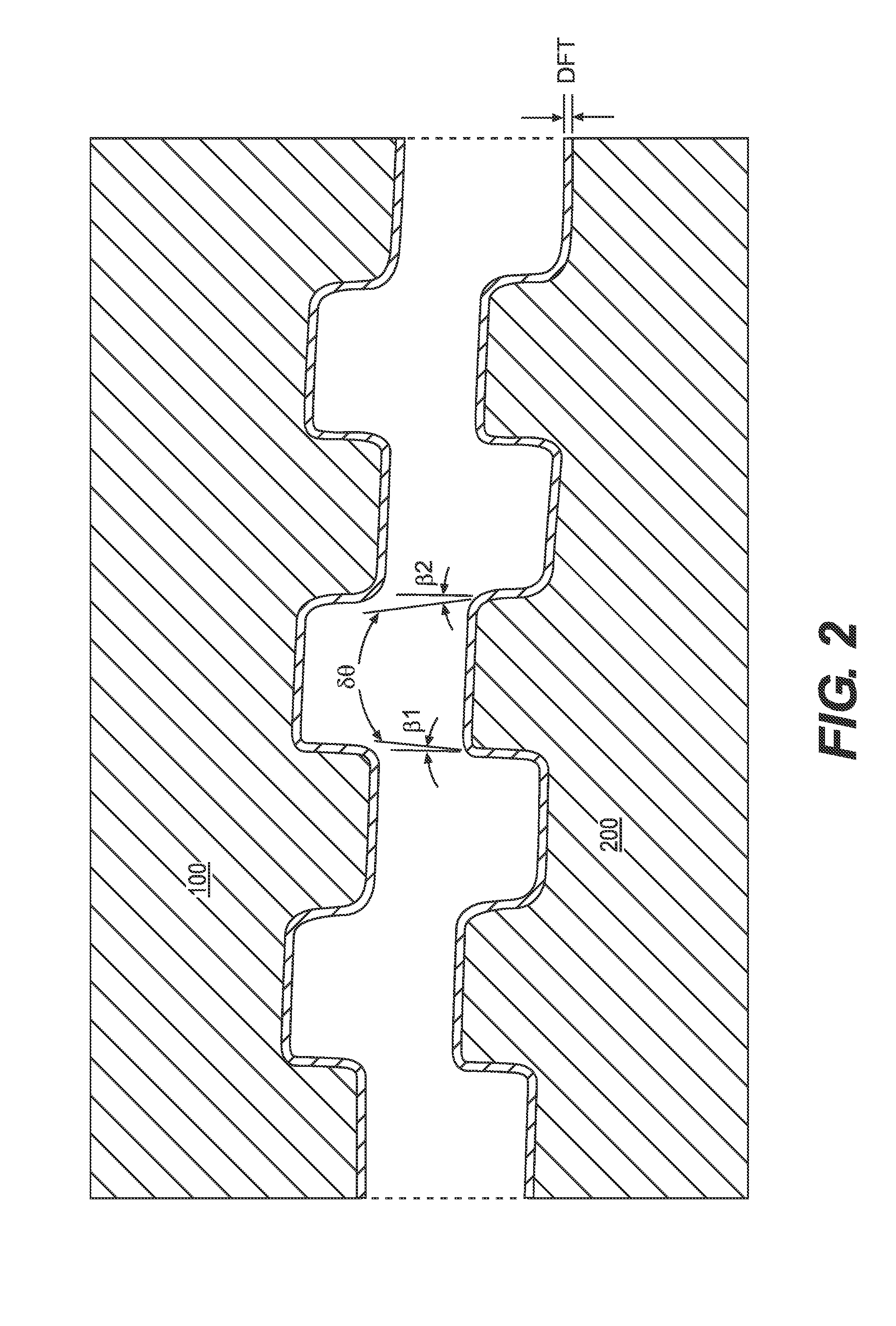Super high torque dope-free threaded joint
a threaded joint, super high torque technology, applied in the direction of screw threaded joints, hose connections, mechanical equipment, etc., can solve the problems of limited prior art technology capable of reaching super high torque performance, damage to threads, and pin edges and box threads may contact, so as to avoid the effect of pressure difference, high torque connection, and high make-up and break-out torqu
- Summary
- Abstract
- Description
- Claims
- Application Information
AI Technical Summary
Benefits of technology
Problems solved by technology
Method used
Image
Examples
example 1
[0044]In this first embodiment, the box 100 and pin 200 members have a flank-to-flank contact thread profile with a low, positive load flank angle [β1 or a.=3°] and a low, positive stabbing flank angle [β2 or b.=5°] for both the box member 100 and pin member 200 so as to define a trapezoidal thread with an included angle between flanks δθ of 8°. Further parameters of this first example include:
[0045]Weight: 12.7 ppf;
[0046]Tpi: 5;
[0047]ν: 0.32 (carbon steel)
[0048]OD: 4.5″; and
[0049]δ (radial interference): 1.5×10−4 m
[0050]The joint of this embodiment was made up with use of a dope, and particularly API 5A3, which is an API modified grease. As can be seen from Tables 1-1 and 1-2, below, the breakout torque was higher than the makeup torque making a significant difference as compared to with the use of dope-free technology, as shown below in Example 2. Also, note that the maximum torque values are much lower as compared to with the use of dope-free technology.
[0051]
TABLE 1-1Maxi-Shoul-...
example 2
[0053]In this second embodiment, the same material and thread configuration of Example 1 is employed. The box 100 and pin 200 members have a flank-to-flank contact thread profile, a low, positive load flank angle [β1 or a.] of 3° and a low, positive stabbing flank angle [β2 or b.] of 5° for both the box member 100 and the pin member 200, so as to define a trapezoidal thread with an included angle between flanks [δθ] of 8°. The joint of this embodiment was made up with use of a two layer, dope-free solution coating that exhibited a dry lubricant and anticorrosion properties, according to the teachings of U.S. Pat. No. 6,971,681 B2, incorporated by reference herein. The first uniform layer was approximately 10 μm in thickness and comprised an epoxy resin containing particles of Zn as a dry corrosion inhibiting coating. The first layer was covered by a second uniform layer approximately 10 μm in thickness and comprised a mixture of MoS2 in an inorganic binder as a dry lubricant coating...
example 3
[0056]In this third embodiment, both the box 100 and pin 200 members have a flank-to-flank contact thread profile, a low, positive load flank angle [β1 or a.] of 3° and a low, positive stabbing flank angle [β2 or b.] of 5° for the box 100 and pin 200 members so as to define a trapezoidal thread with an included angle between flanks [δθ] of 8°. The joint of Example 3 was a 4.5″ connection of grade L80 API steel with a torque shoulder, having a weight of 12.6 pounds per feet (ppf) and a diametrical interference between 0 and 0.5 mm. Further parameters of this third embodiment include:
[0057]Weight: 12.7 ppf;
[0058]Tpi: 5;
[0059]ν: 0.32 (carbon steel)
[0060]OD: 4.5″; and
[0061]δ (radial interference): 1.5×10−4.
[0062]The joint of Example 3 was made up with use of a dope, and particularly API 5A3, which is an API modified grease. As can be seen from Tables 3-1 and 3-2, below, the breakout torque was higher than the makeup torque. Again, there is a significant difference as compared to the fir...
PUM
 Login to View More
Login to View More Abstract
Description
Claims
Application Information
 Login to View More
Login to View More - R&D
- Intellectual Property
- Life Sciences
- Materials
- Tech Scout
- Unparalleled Data Quality
- Higher Quality Content
- 60% Fewer Hallucinations
Browse by: Latest US Patents, China's latest patents, Technical Efficacy Thesaurus, Application Domain, Technology Topic, Popular Technical Reports.
© 2025 PatSnap. All rights reserved.Legal|Privacy policy|Modern Slavery Act Transparency Statement|Sitemap|About US| Contact US: help@patsnap.com



